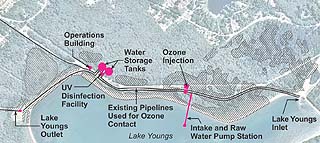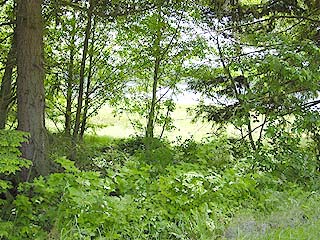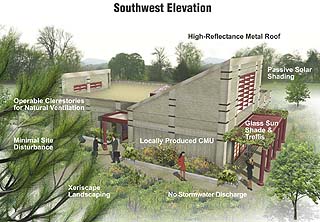
Surveys
DJC.COM
July 25, 2002
Making clean water the green way
CH2M Hill

Parker |
Seattle Public Utilities’ Cedar Water Treatment Facility at Lake Youngs Reservation in Renton carries on the city of Seattle’s tradition of protecting water quality, incorporating features of sustainability, and preserving the natural environment in the Cedar River watershed.
The facility is being designed, permitted, built and operated under a design-build-operate (DBO) contract between Seattle Public Utilities and CH2M Hill Constructors Inc. (CCI). CH2M Hill’s engineering company is responsible for the design and permitting; CCI will build the facility; and sister company Operations Management International will be responsible for operations over the next 15 to 25 years.
The integrated CH2M Hill team recently completed the design and permitting of this facility, which combines the use of an innovative water treatment process with the reuse of existing site facilities to create the least impact on the environment — a forested reserve surrounding a lake and numerous wetland systems.

Image courtesy of CH2M Hill Wetlands are being preserved at Lake Youngs by dispersing development sites and using smaller building footprints. |
Following the city’s directive on capital projects, the design of the facility’s operations building goes an extra step to include sustainable design elements that will qualify it for a US Green Building Council’s LEED Silver rating. When operations start in 2004, the 180-million-gallon-per-day facility will treat two-thirds of the water for Seattle Public Utilities’ 1.3 million customers.
“The request for proposals for this project was structured to encourage innovation in incorporating environmental sensitivity and features of sustainability into all phases of the project,” said Chuck Clarke, director of Seattle Public Utilities. “Each proposing team had a slightly different approach to this, but SPU found all to be refreshingly creative. CH2M Hill’s proposal included the best combination of a technically sound treatment process, strong project team, environmental and sustainability features, and life cycle cost.”
Preserving wetlands
“Back at the proposal phase, we decided to go down a path of least impact and worked with environmental planners and scientists to avoid sensitive areas from the outset,” said Scott Trusler, CH2M Hill’s design manager. As a result, the design and permitting strategy was based on avoiding all impacts to wetlands and avoiding or reducing all other environmental impacts, including impacts to neighboring residents.
By trying to avoid impacts to wetlands, the project reduced the risk of a delay or failure to secure environmental permits and recognized the city’s priority to minimize impacts to the environment and surrounding community.

Photo courtesy of CH2M Hill Wetlands near the future site of the Cedar Water Treatment Facility. |
Wetlands and associated buffer areas dominate the eastern shore of Lake Youngs, but that was the best general location for the facility due to proximity to water system components. To avoid the wetlands, designers developed a dispersed site layout, minimizing the footprint of new facilities and maximizing the reuse of existing infrastructure. This approach also helped designers minimize impacts to neighbors by locating the facilities as far away as possible from the reservation’s boundary. In addition, the raw water intake and pump station was designed with underwater pumps to mute their noise and eliminate potential disturbance to nearby residents.
The project design uses existing pipelines for part of a disinfection process known as ozonation. Water must remain in contact with ozone a sufficient amount of time to be effective, which typically requires large contact basins. By using the existing pipeline and providing in-line ozone contact, designers reduced the size of the new building needed for ozone contact. The existing chlorine building and pump stations are also being reused or adapted.
In addition to reducing site impacts, the reuse of existing pipes and facilities avoids use of new materials that would need to be harvested, produced, manufactured and transported to the site. The intake and raw water pump station was sited in the only location possible to avoid onshore wetlands. Site circulation and access uses existing service drives and maintains their gravel surfaces, avoiding having to clear trees or impact wetlands.

Image courtesy of CH2M Hill The operations building facilitates natural heating and ventilation through operable glazing, passive solar shading, sloping roofs and a large thermal mass. |
As the design developed, biologists went out to the site to confirm the location of wetlands delineated during the environmental review process. During their reconnaissance, the biologists discovered two previously unidentified wetlands. The then-proposed footprint of the water storage tanks would have affected one of these newly-found wetlands. To avoid the wetland, designers moved the storage tanks but could not avoid impacts to a smaller isolated wetland of lesser quality.
To compensate for the impact to the .03-acre wetland, a section of a road within a large open water wetland system will be removed and wetland vegetation restored.
Greening the operations building
In addition to protecting the site’s natural environment and the neighbors, the design team considered the environment into the future by incorporating green design elements into every facet of the project’s operations building. Working with green building consultants Paladino & Co., principal author of the LEED Reference Guide, and Seattle Public Utilities, the designers incorporated recycled materials, natural heating and ventilation, solar access, energy efficiency, and water conservation into the design.
At least 25 percent of the materials specified have recycled content, with a goal of achieving 50 percent for both exterior and interior work. Materials include recycled plastic toilet partitions, gypsum wall board, concrete rebar, carpet and ceiling tiles.
In addition, a primary goal is to have 20 to 40 percent of the materials manufactured and harvested locally, including the concrete block, certified wood, metal doors and windows, and fly ash in concrete.
Many of the materials are also made from renewable sources such as, rubber flooring, landscape mulch, cellulose insulation, and straw and wheatboard for walls and casework. Further, certified wood from sustainable forests will be used for movable meeting room doors.
The construction waste management plan for the project has a goal of diverting the maximum amount of construction waste materials from the landfill by such means as recycling wood forms, waste material and packing materials. Construction workers will reuse or salvage materials, and will track materials for recycling, salvage or disposal.
After the operations building is occupied, staff will have an area dedicated for recycling as part of an ongoing recycling plan for the facility.
The operations building, which will be staffed 24 hours per day, has integrated energy-saving measures. The structure facilitates natural heating and ventilation through strategically placed operable glazing, passive solar shading, sloping roofs and a large thermal mass.
On a portion of the roof, high-reflectance metal roofing reduces heat island effects in summer, and clerestories automatically open to purge warm air. A heat recovery duct on the south end of the building captures radiant heat, which is used to warm other parts of the building interior.
High performance lighting and HVAC systems as well as Energy Star rated appliances further reduce energy demands.
Monitoring the vision
The construction team, along with operations staff, participated from the beginning in the development of the design concept. They are now implementing the combined vision of the designers, permit specialists, environmental scientists, constructors and operators.
An environmental monitor, as well as noise monitor and archaeologist, are onsite to ensure compliance with permits, erosion and sedimentation control requirements, and protection of the water quality of the lake.
Construction techniques to control erosion and sedimentation include storm inlet protection; filter fabric fencing; temporary/permanent planting and mulching; erosion control mats; interceptor ditches, dikes and swales; wetlands monitoring; and sediment traps and stormwater ponds. Several of the sediment traps and ponds used during construction will become permanent stormwater facilities.
The environment has benefited from the integrated DBO approach as the designer becomes the builder, who will become the operator that carries forward their company’s and client’s vision of protecting and preserving the environment.
Lorie Parker is CH2M Hill’s environmental and permitting manager for the Cedar Water Treatment Facility DBO Project.
Other Stories:
- Water storage goes underground
- Getting back to basics with LEED
- Seattle LEEDs the nation in sustainable building
- New stormwater rules looming for contractors
- An incubator for cutting-edge power projects
- Linking up with the environment
- Designers find new life for old cardboard tubes
- EPA turns up the heat with temperature rules
- AGC teams with WSDOT for environment’s sake
- A wholistic look at engineering
- Toxic black mold — the next asbestos?
- Mold: Getting a grip on the fuzzy stuff
- A trail of mining waste turns into a trail of recreation
- No more fuming at chemistry class
- A battery of energy information
- New brownfields law comes with big changes
- ‘Green infrastructure’ puts Seattle on the map
- Detention ponds – all it takes is a little magic
- Ground zero for groundwater
- A pearl of a project on Oyster Creek
- BetterBricks program stacks up energy savings
- Shopping ‘green’
- Home Depot builds atop an old Oregon landfill
- Salmon in the city: Seattle restores fish habitat
- A funny thing happened on the way to the dump
- Reducing energy costs, post crisis
- Managing stormwater in Pierce County
- Does best available science work for all buffers?
Copyright ©2009 Seattle Daily Journal and DJC.COM.
Comments? Questions? Contact us.